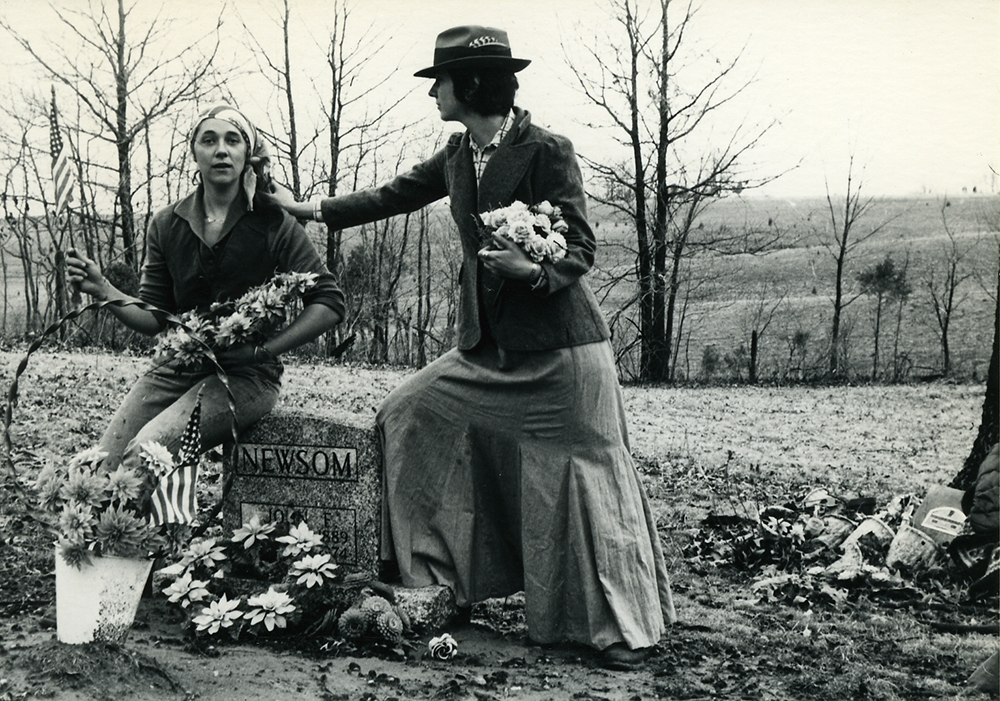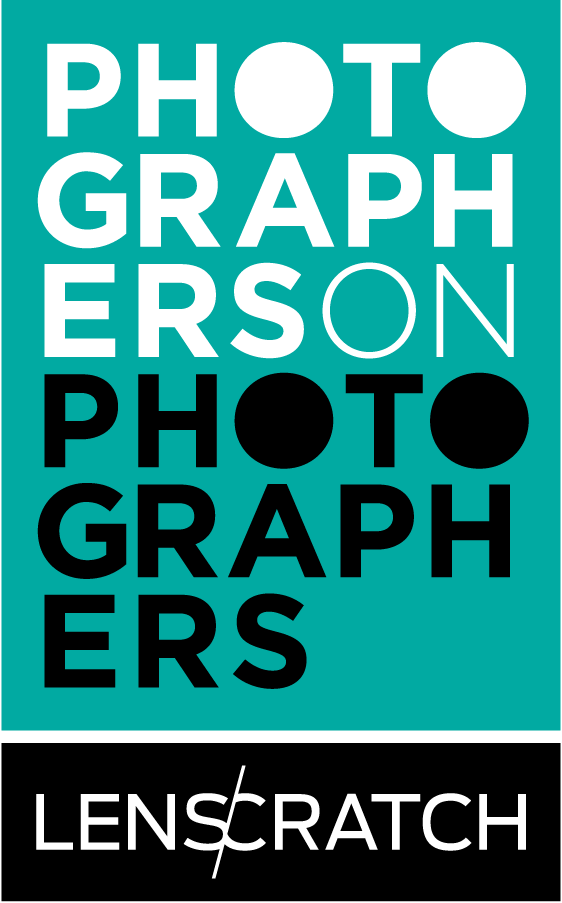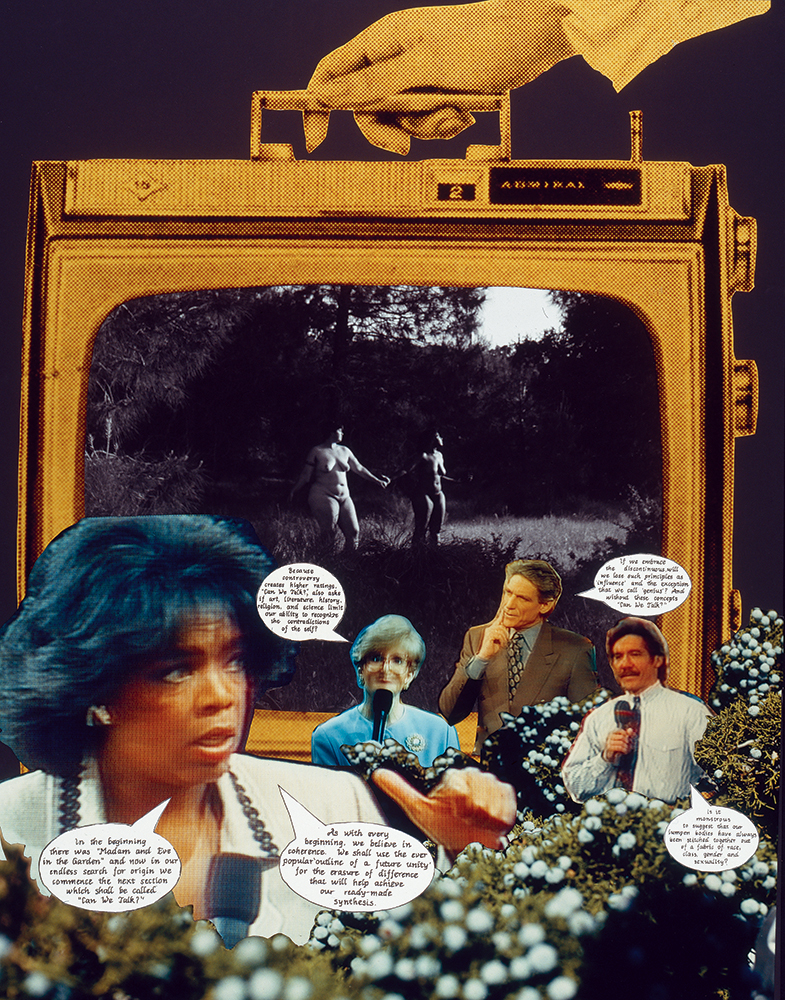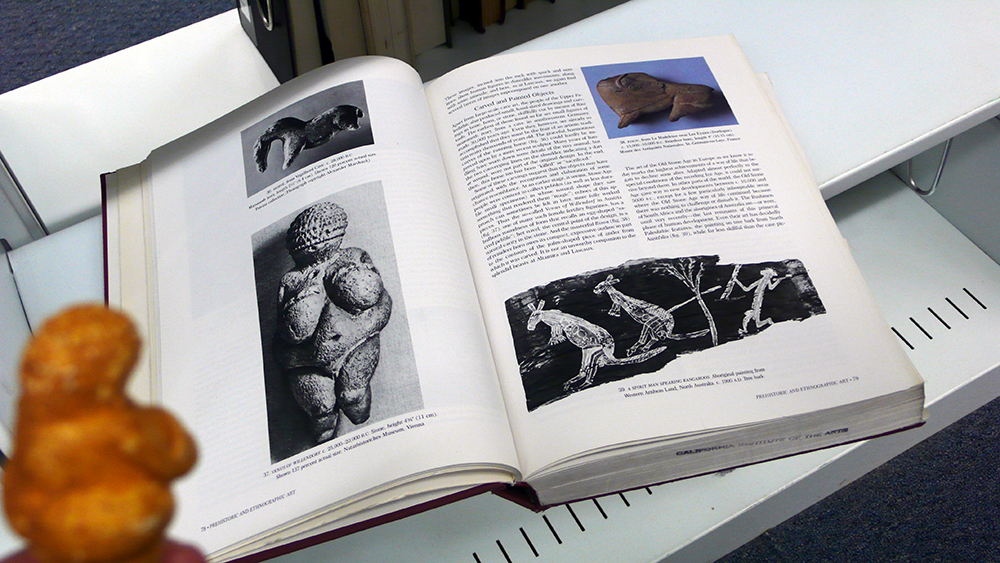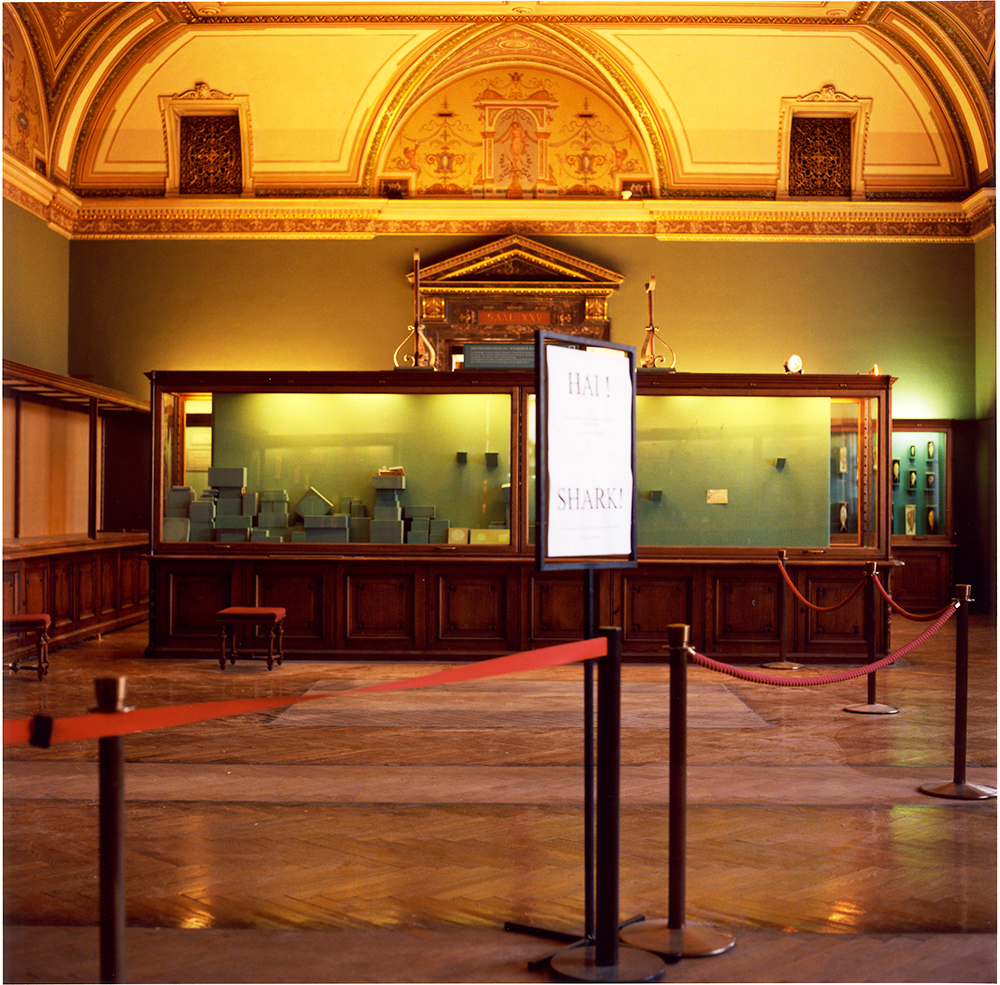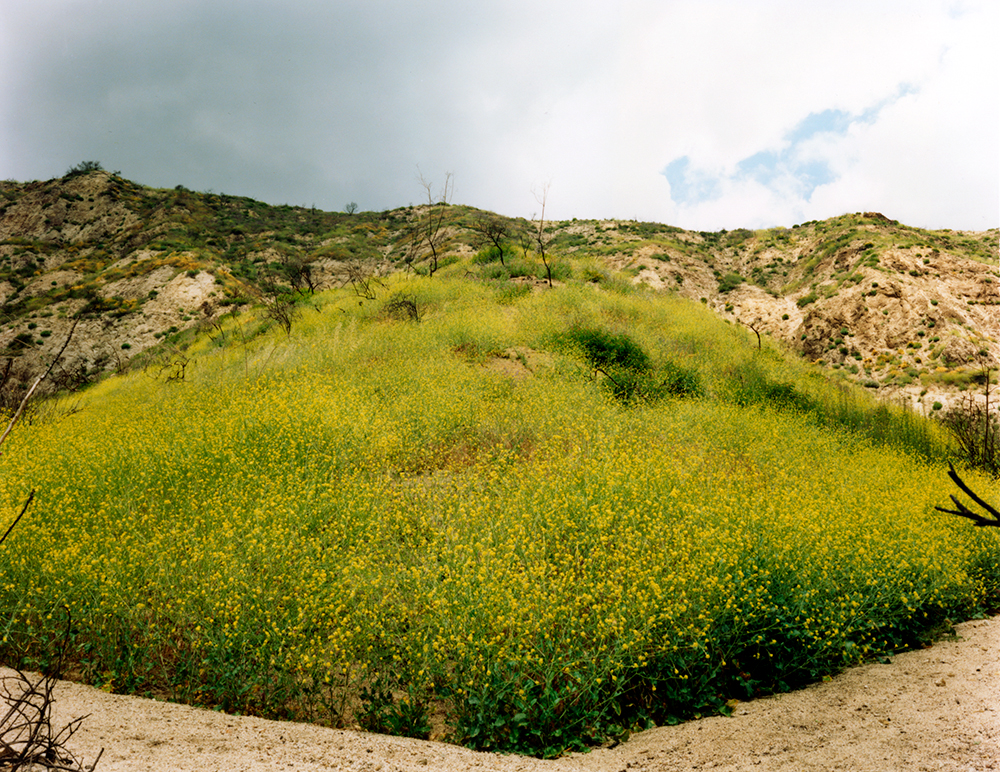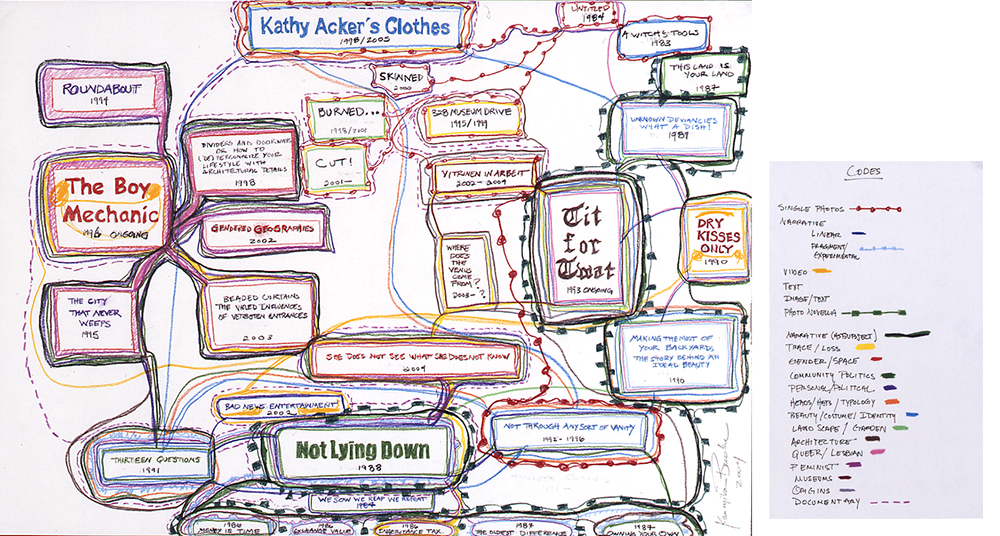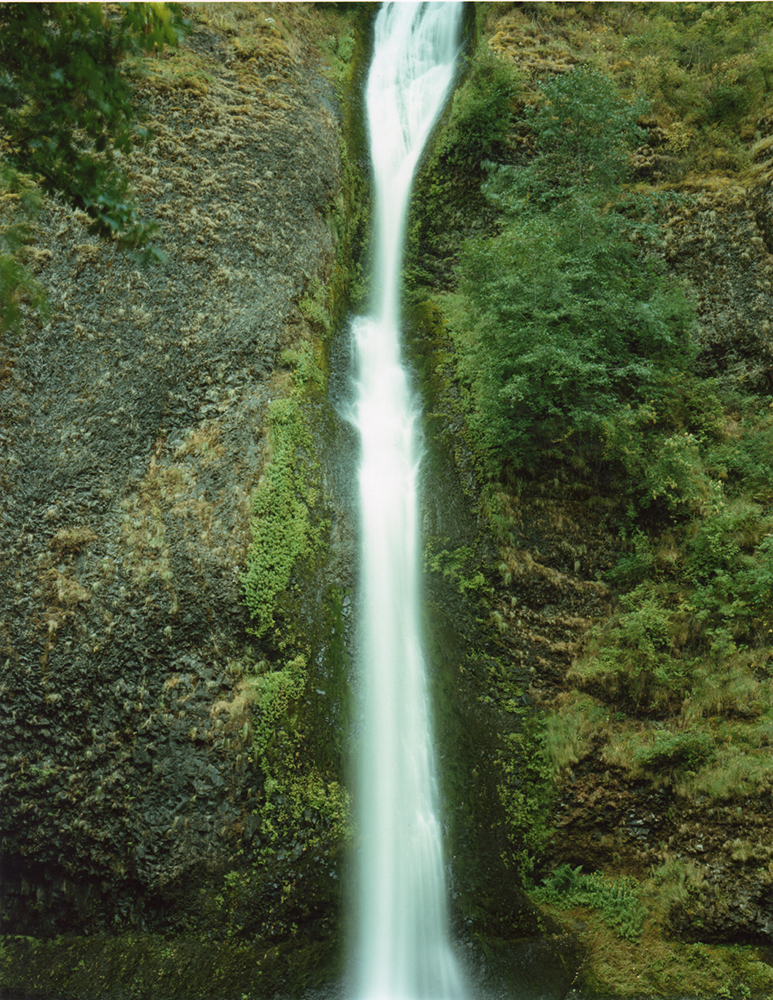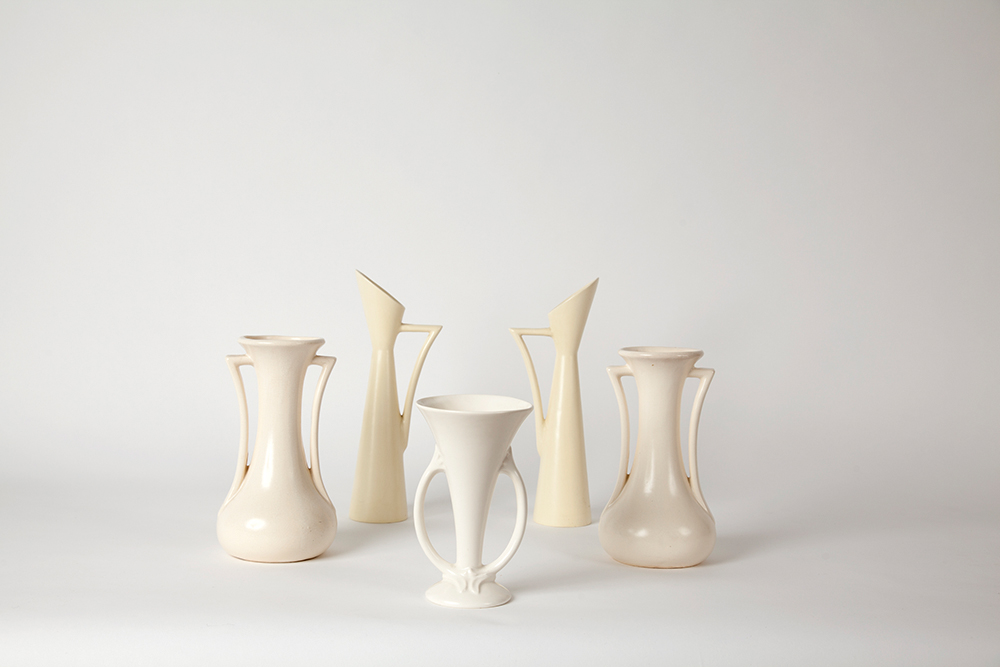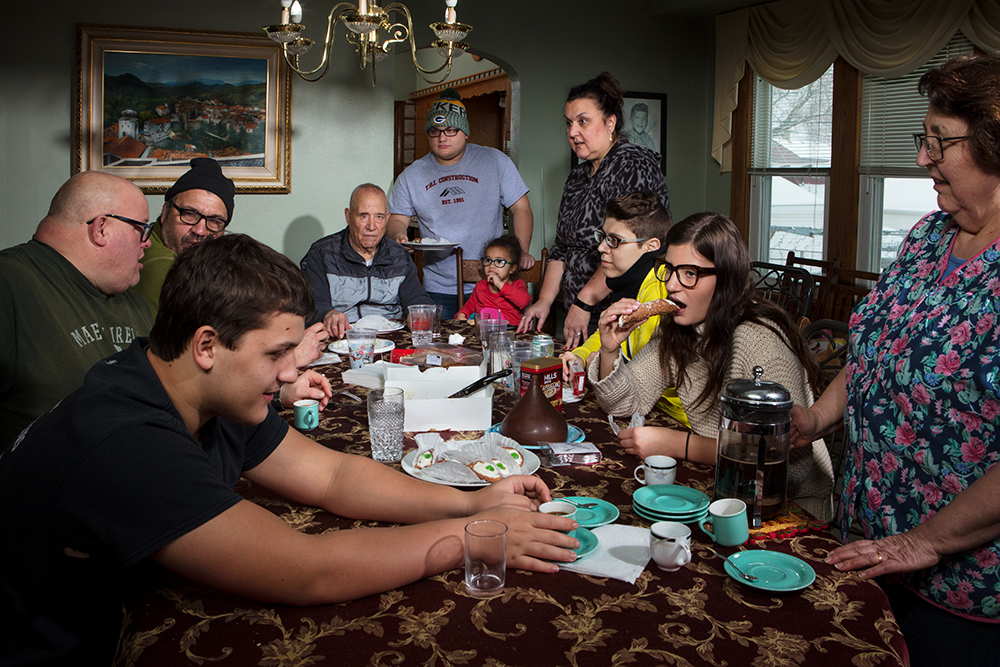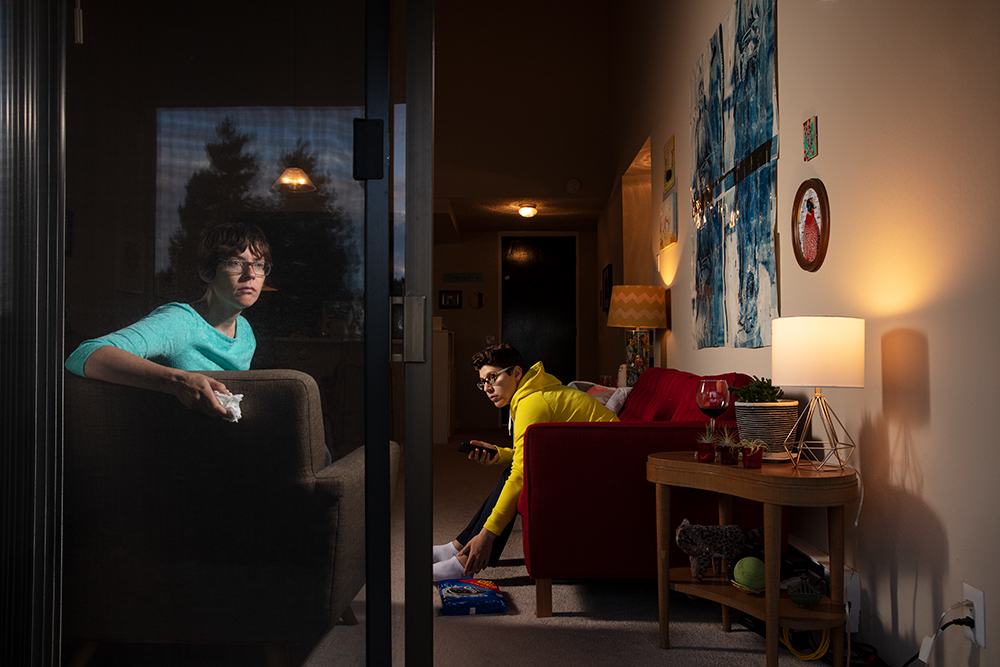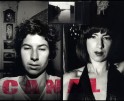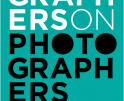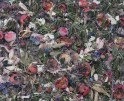Photographers on Photographers: Lois Bielefeld in Conversation with Kaucyila Brooke
Kaucyila Brooke’s work is accumulative- it bifurcates and then feeds back in on itself which parallels the complexity of this world. In her 50+ year practice she has continued to focus on ideas of identity, feminism, and queerness as she critiqued the slowly shifting culture and rights for some people and not others. She has held space for feminism and lesbian identity while also probing traditional notions of photography through her use of multiple images, narrative, pop culture, and origin myths often wrapped in humor.
I met Kaucyila as a prospective student MFA portfolio day in Chicago. I had not been considering CalArts as a potential fit but our conversation was so rich with connection and insight that I became very interested and intrigued by the program. Kaucyila has been teaching at California Institute of the Arts since 1992 in the Photo/Media program just outside Los Angeles. In 2019 I was accepted into the program and thrilled to have Kaucyila as my mentor. My work is accumulative as well with compounding and seeking understanding through collecting. This interview is a reflection of that basic tenet of accumulation and refusal to edit down to a single story or generalization. This is a reservoir of an interview filled with details, heart, and ultimately the complexity of a life practice.
Kaucyila Brooke is an artist based in Los Angeles. Brooke’s multidisciplinary practice addresses the politics of cultural production and sexual representation. In diverse narrativized and serial formats, including large-scale photomontages, photo novellas, and photographic archives, she reevaluates the status of the photograph as object. Brooke also investigates strategies of knowledge production in institutions, urban structures, and the private sphere, analyzing the ways in which Enlightenment thought invented, revised, collected, and displayed their curiosity about science, the body, art, and nature.
Brooke’s work has been shown in a number of international galleries and institutions, including solo exhibitions at Echo Park Film Center, Los Angeles, CA (2017); Commonwealth and Council, Los Angeles, (2010, 2013); and The Badischer Kunstverein, Karlsruhe, Germany (2012). Recent group exhibitions include Art After Stonewall, Grey Art Gallery, NYC, Columbus Museum of Art, Columbus, OH (2019-2020); Queer California, Oakland Museum of California, Oakland, CA (2019); Bucharest Biennale for Contemporary Art, Romania (2010); The Eighth Square – Gender Life and Desire in the Visual Arts since 1960, Museum Ludwig, Cologne, Germany (2006); and The Berlin Biennale 3, Germany (2004).
Kaucyila Brooke has been a member of the faculty in the Program in Photography and Media at California Institute of the Arts since 1992.
Follow Kaucyila Brooke on Instagram: @kaucyila_brooke
Lois Bielefeld: How did you come to photography?
Kaucyila Brooke: I always had a camera, a Brownie, an Instamatic and I took pictures and kept photo albums. My mother also liked to take pictures and knew something about art. I lived in Oregon City, a small mill town outside of Portland. My mother did take me to the Portland Art Museum, but there were no art classes at my high school. I became an English-Lit major in college because I loved reading and analyzing text.
After college, I had no career ambitions. It was the seventies and I wanted to experience more of the world and find out about things I knew nothing about. I was a hippie. I hitchhiked for adventure and met people who I had never come across in my middle-class sheltered life. In 1974, I randomly moved to Columbia, Missouri. One day a friend and I were sitting behind the laundromat and she said to me, “If you knew you were going to die in a year, what would you do with your, with the last year of your life?” And I said, “I don’t want to answer that.” But I immediately had an answer, “I would go to art school.” My whole stomach went upside down.
But first I came out. Missouri was clearly not at the cutting edge of the lesbian feminist revolution and I wanted to be a part of it. In 1975 I moved to Eugene, Oregon and began hanging out with these dykes who were reinventing themselves. I wanted to photograph them. My mother gave me her old camera from the 1920s, which was a Kodak number 1 pocket camera with expanding bellows and she gave me a 35mm Kodak camera. I started taking black and white photographs of my friends out in nature in costumes and in dramatic poses.
In Eugene, we had a feminist newspaper called Women’s Press and I started taking photos of demos, journalistic assignment work, and advertisements to attract subscribers. That’s how I got started. I started taking classes at the community college. I immediately was obsessed with the darkroom, I would lose all sense of time. I wanted to figure out how to make a good negative and print. Having grown up with Life magazine, I thought being a documentary photographer was important and was something that would contribute to looking at the world.
In 1981 I went to the Maine Photographic Workshops and it was the first time that I’d ever been able to think about photography 24-7. I hardly slept, I was so excited. It was a conventional teaching situation and I was at odds with the institution. They taught the history of white male photography. I challenged them and they said, “Why don’t you just make your work, you’re causing too much trouble.” Despite their warning I was able to challenge their hierarchy and make a lot of work.
I was interested in using multiple images to acknowledge complexity, the passage of time, and the intersections of various viewpoints. I thought of this as a direct challenge to the notion of the masterwork and the cult of the single image. I returned to Eugene and joined a collective gallery called Project Space where I began exhibiting work. I attended the University of Arizona at Tucson when I was 31. It was kind of rough going there because it was so hot and bright. The first thing I did when I got there was Ansel Adam’s nine negative test. The way I had photographed in the Pacific Northwest wasn’t working and I had to start over again.
I continued to make work about women’s relationships that was both playful and specifically queer. People there weren’t really out, even though it was 1982. It wasn’t really a problem for my professors, but I think it didn’t fit so well with my colleagues. I wanted lesbian identity to be included but I wasn’t trying to make positive image work. One guy in my program took me aside and warned, “I really like you, but if you’re going to have a career in the art world you can’t continue to make this feminist or lesbian work. Nobody’s going to take you seriously.”
Lois Bielefeld: Women’s rights and queer rights have massively changed during your career and yet again in this present moment. Seeing that feminist ideas and queer representation have been focal points throughout your work, talk about this evolution and how things have shifted for you with different waves of feminism and queer public acceptance.
Kaucyila Brooke: I grew up in a world where I didn’t know any professional women. There was one woman who was a lawyer who was the mother of a friend of mine, she was a single mother. My dad told me if she wasn’t a woman, she probably would be much more well recognized. When I started making work, there was the beginnings of lesbian photography with artists like JEB (Joan E. Bryant) and Tee A. Corrine. There were workshops called Feminist Photography Ovulars in Southern Oregon, organized by Ruth and Jean Mountaingrove. They called them Ovulars to avoid the word Seminar. I didn’t identify with either the imagery or lesbian separatism. Even though I started out publishing my pictures in Women’s Press, I had trouble with the expectation that I would only show positive images. In other words, one shouldn’t air dirty laundry in public, because officially our identity was classified a mental illness/perversion. Even though we were all unashamed, hairy, braless, changing our names, radical in our anarchist politics, and didn’t give a fuck what men thought about us, we knew that we weren’t safe and certainly we couldn’t be ourselves and be in the mainstream world. We could only exist in our marginal sphere where we could watch out for each other. The ‘positive image requirement’ didn’t ring true for me as any kind of real empowerment.
Women kept thinking if they worked harder and did all the right things that they could succeed. Lesbians had the double whammy of being women and queer. I instinctively knew that there was no unified perspective. I was one artist making work. I wasn’t a spokesperson for a group of people. My job was not to say the “right thing.” As women, we had no idea what we could do or what was possible. We were so surrounded and told that we couldn’t be any of these things: we couldn’t fix a car, we couldn’t add up numbers, we couldn’t drive, we couldn’t be in the Senate. We could obviously never be President. We have different hurdles now.
I was excited to explore what would be possible without the universality of the male pronoun. Everybody I knew was a she. I wanted to think about the language of power and how that was infused within women’s relationships. Not that the patriarchy would go away, of course. I didn’t think that lesbians were somehow separate from these kinds of hierarchies. Multiple imagery and narrative served the work because it moves away from this unified subject position into a discursive approach. And now, the use of they as a nonbinary pronoun insists on this multiplicity.
At some point in the mid-nineties, at the height of the AIDs crisis, people got very conservative around their sexuality. But now with non-binary and the transgender politics, I think queer art and culture are being revived. And I think it’s opening up the possibility of multiple identifications. You could change the way you identify from your pronouns to your appearance for different phases of your life. The idea of having an unstable identity could be accepted. All that academic language about multiplicity and marginality is actually coming true in a first-world context. Okay, not in Ethiopia where you can be sentenced to death for identifying as queer. But, I think it’s kind of amazing that this idea of multiple genders keeps evolving and that play is so much a part of that identification. We think it could never go back again, but the politics right now with the radical right and the grip that they have on the legal system… I mean, I never thought we would lose abortion rights… LGBTQ rights are also on the chopping block. We could very well backslide back into those periods where people are in the closet again in different ways and have to hide their identities. The art world always seems like it’s the bastion of liberalism, but it’s the money that’s behind the art world that is conservative. I mean, I just think money, in general, is conservative. So this could also happen.
You think whatever the present moment is, is what it is. You think you’re the most radical. When you get a little bit older, you have some historical perspective.
Lois Bielefeld: Your work is very research-based. How do you approach your research? And how’s that woven through one or two of your series?
Kaucyila Brooke: I’ve been told that my work looks heavily researched first and then executed. Actually, it’s a whole mixed-up process. Sometimes I get a title and that leads me toward the subject matter and then that leads me towards research. Other times, I’m doing research in advance which leads to a project. Most of the time, the project seduces me and I get curious.
In Tit for Twat, which I started in 1992, after watching the then popular trash tv talk shows, I found it amusing that the public and the hosts were befuddled by the existence of queer people. None of them could figure it out and at one point in an act of liberal generosity, Oprah suggested that we were as rare as finding a 4-leaf clover in a field. The producers would plant someone in the audience from the American Family Association. The hosts would know in advance where they were seated and ask them to voice their opinions because this created controversy and spiked their ratings. But it wasn’t discourse; it was totally tit for tat. They’d say, “If God had intended homosexuality in the garden of Eden, it would’ve been Adam and Steve, but it wasn’t! It was Adam and Eve!” So I was thinking who would be the lesbian version of this? That’s how I started thinking about Madam and Eve.
Madam and Eve question the basic western pillars of patriarchy, power, and religion. A friend once said that, “Madam and Eve go wherever Kaucyila goes.” It’s true. I started wondering: what are the various origin narratives and how are origin narratives organized? What about nature? How do we talk about nature? What is nature and why do we say human nature? And what do we mean by that? What do we project from ourselves onto the natural world? These were avenues of exploration that opened up for me in my research for the project. Also I questioned: what do we consider primitive? What is the history of the idea of the primitive? How do these ideas confirm our narrative of being civilized? Each one of these questions launches me in a research direction.
In The Boy Mechanic, which is about the history of lesbian bars, the research is localized to the community. I look through local and national LGBTQ archives and I interview local bar patrons. Theoretically I research vernacular and urban geography, politics of queer space, and architectural history.
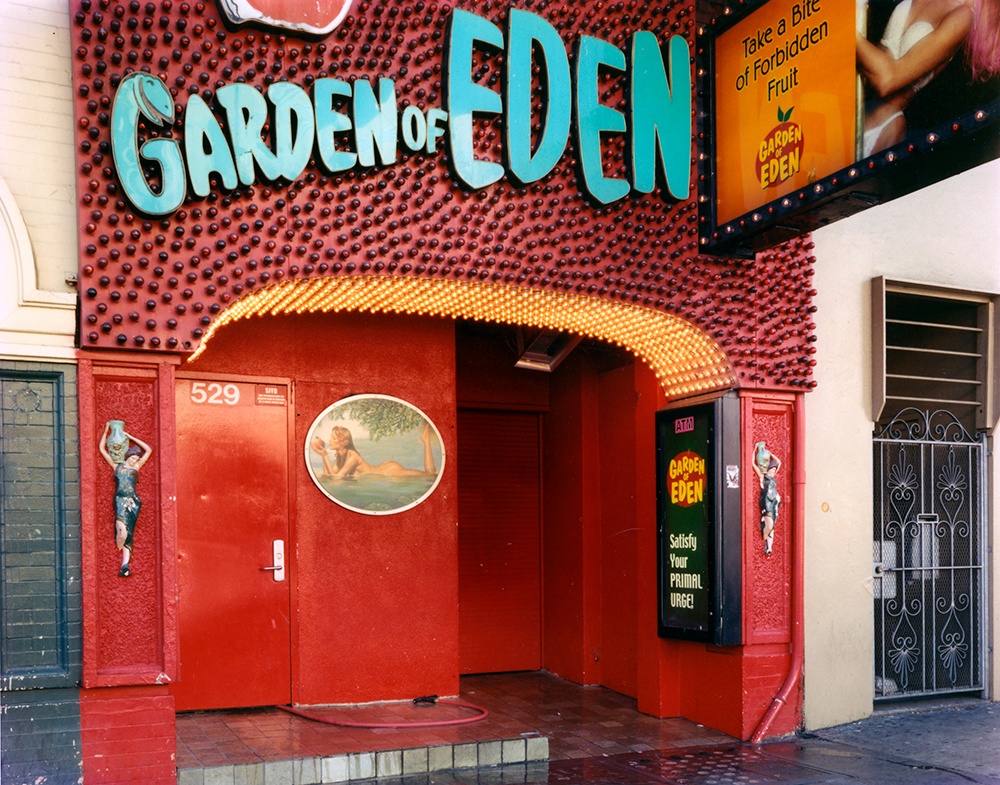
The Boy Mechanic: Garden of Eden (formerly Tommy’s Place), San Francisco, California, 2007, © Kaucyila Brooke
For Vitrinen in Arbeit, I photographed in The Natural History Museum in Vienna from 2002 until 2004. My initial reason for visiting the museum was to see the Venus of Willendorf. I thought that the Venus should come into the Tit for Twat narrative.
Natural history museums are tasked with explaining human origins. It’s usually a gendered story, one that shows women cooking and men hunting, and other obvious cavemen tropes. I discovered that they were in the process of changing the display of their entire 19th-century collection from a study collection to an American-style didactic display. In this case, my research for Tit for Twat led me to the museum and out of that, I initiated several new project including a performative lecture Where Does the Venus Come From? Often my projects are generative and end up inspiring other projects. It’s a different way that the research expands.
Lois Bielefeld: I’ve had the fortune to have you for 3 very different classes— Landscape: The Wilderness; Heroic Distortions: Visual Arts Narrative; and Queer Critique Potluck. I’m really interested in how the courses you’ve taught both intersect and weave into both your interests but also throughout your work? Especially the continuous threads of both narrative and the landscape within your work. How has teaching impacted your practice? Is there a reciprocal relationship?
Kaucyila Brooke: At CalArts the faculty have academic freedom to shape the curriculum. I teach classes that address either photographic genres or theory. But of course, they have to do with my own artistic research. Heroic Distortions: Visual Arts Narrative is a class I developed when I was teaching at UCSD and I continued to modify it over the years. I teach a graduate seminar called The Origin and the Copy and Other Strange Creations. The course addresses the status of the photograph, which has always been lower because it’s not one of a kind, it’s a copy. Teaching also informs my research about narratives of origin and originality. The landscape classes that I teach have to do with how we understand nature and how that understanding changes historically. In the class you took, Landscape: The Wilderness, we looked at the concept of the wilderness and its history. I line up ideas about discovery with the understanding that ideas and ideologies are historical. I’m trying to put a wedge between any kind of naturalization such as, “that’s the primitive brain kicking in” or “that’s instinct.” There is an ideology here. There is a power structure. The other class I teach is Landscape: and The Garden. The garden is manipulated but so is the wilderness. We are the ones that call it nature. We’re constantly interacting with nature. It forms us and we form it. We created the separation. The alienation is a self-fulfilling prophecy.
I have used landscapes as theatrical backgrounds in my narratives, like the ocean in Unknown Deviancies: What A Dish! In, Making the Most of Your Backyard: The Story Behind an Ideal Beauty, the location is the garden.
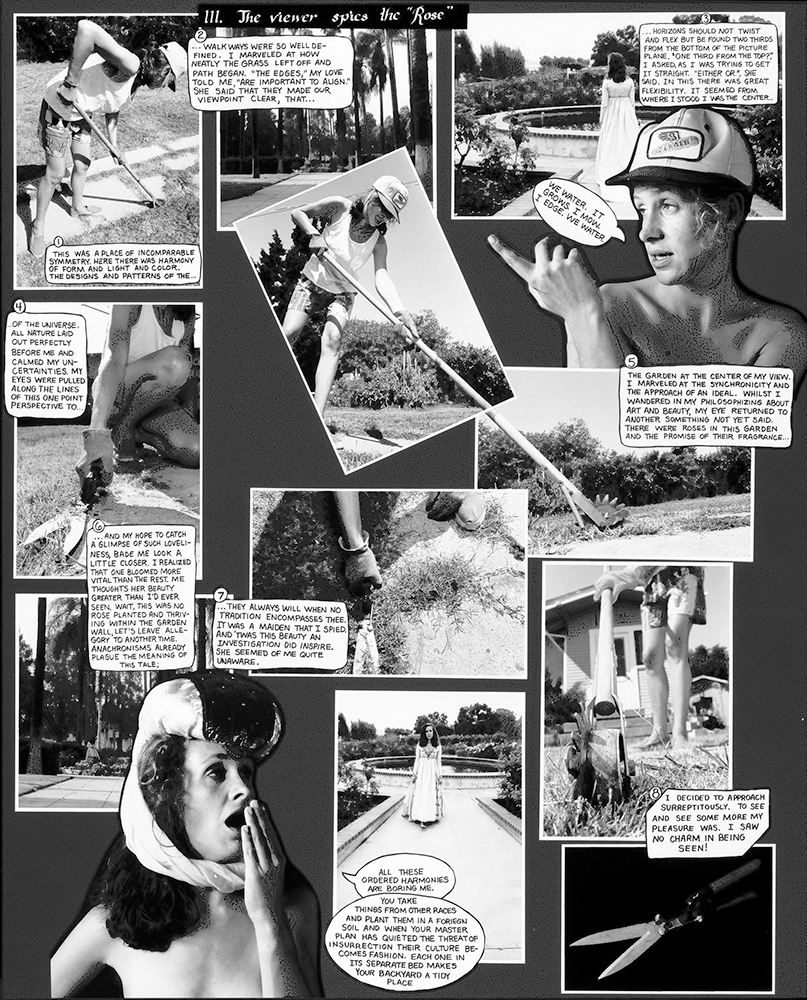
Making the Most of Your Backyard: The Story Behind an Ideal Beauty: II. The Viewer spies the “Rose” 1990, © Kaucyila Brooke
Then I explored moving the landscape into the foreground. There was a fire in Griffith Park in the fall of 1997. I started photographing it because I thought it was a good location for hell (Madam and Eve should check out hell too). I became fascinated with how it looked and with tracing the regrowth.
Lois Bielefeld: And you were shooting large format, correct?
Kaucyila Brooke: Yeah, I was hiking in once or twice a month to photograph it as it was changing and this developed into the series Burned…
In terms of the reciprocal relationships established through teaching, I love meeting all of the younger artists who are coming through, on their way to something else. They introduce me to so many subjects, so many terrains, and so many views into the world that I wouldn’t have had access to. I think teaching for the most part is a generative symbiotic experience.
Lois Bielefeld: How do you measure success in your career?
Kaucyila Brooke: Well, certainly not by the size of my bank account. The American narrative of success is fame and fortune. Success in the art world is no exception to this. For some artists it is particularly difficult to take on the entrepreneurial role. This really doesn’t have anything to do with the worth or the merit of the work. The art world is not a meritocracy and I don’t know if it ever has been.
I came from a family or a region of the country that doesn’t recognize art as a career choice. Consequently, it took me a little longer to realize this was a possibility for me. It was a personal victory that I had the strength to imagine my life as an artist without knowing that it was sustainable. Each step along the path from my first solo exhibition, to grad school, to teaching positions has been a leap of faith. Sustaining my practice and financially supporting myself for 42 years for me is the measure of success.
In 2012 I had a survey show at The Badischer Kunstverein in Karlsruhe, Germany where I worked with an amazing feminist curator Anja Casser. We made an exhibition that focused on my narrative projects: Tit for Twat, Unknown Deviancies: What a Dish!, Making the Most of Your Backyard: The Story behind an Ideal Beauty, Kathy Acker’s Clothes, After Morandi and After GLH, The Killing of Sister George, 13 Questions, and this was the first time I showed the Un-Entitled Certificate and the Unofficial Seal. In order to include my working methods, materials, and other narrative works for context we exhibited archives of publications, journals, sketches and maquettes in vitrines throughout the rooms. Seeing all of this work together was immensely satisfying to me. It allowed me to see the connections and was quite moving.
We called the exhibition, Do You Want Me To Draw You A Diagram?, which is also the title of a series of drawings that we also showed. In 2004, Martin Prinzhorn wrote an article, Kaucyila Brooke: Borderlines for Camera Austria International in which he focused on the connections between seemingly disparate works. His analysis acknowledged the complexity and the entanglements throughout the work and I felt recognized. After reading his article, I thought, “Okay, so that’s not so difficult to understand. What do they want? Do they want me to draw a diagram to explain how these projects relate to one another?” And then I thought, “Oh!, I’m going to do that. I’m going to diagram it out.” I have been making a series of drawings, which diagram the relationships between the projects. I thought of the exhibition as an architectural diagram of the works and the matrix of their kinships.
In 2008, Shaden Verlag, Cologne published Kaucyila Brooke: Vitrinen in Arbeit a 11.5×12” hardcover monograph. Along with the photographs it includes an introductory essay by Christiane Stahl and an extensive interview by art historian David Joselit. I was thrilled! I took it home to show my family…my dad looked through it and said, “Well, what is this for?” I explained, “It’s a book. It’s a book of my work.” And he asked, “Well, where do they sell this book?” And I answered, “It’s in museum bookshops and bookstores. ” And he said, “Do a lot of people pay money for these things?” And I said, “Well, no, I’m not going to get rich off this dad. But you know, it distributes my work.” And he just shook his head.
I didn’t expect a party. But something that signified this idea of success to me, something that was an actual object that I thought anybody could understand if you handed it to them, was still unrecognizable within my family context. This demonstrates to me how success is relative and personal and not universal.
Lois Bielefeld: There were two more projects I’d like you to share about, in this interview. Will you talk a bit about The Last Time I Saw You and After Morandi and after GLH?
Kaucyila Brooke: Both of those projects are personal in a way that most of my work is not. The Last Time I Saw You is a series of seven photographs that I took along The Historic Columbia River Highway in Oregon near where I grew up. I had been thinking about the sublime, as it was understood in 18th century Germany. One of the ubiquitous motifs was the cataract– this gush of water, this force of nature, and all of this energetic intensity of waterfalls. I went to see the longest waterfall in Germany in the Black Forest. I thought I could recognize how the Germans conceived the sublime. What I saw was nothing, just a long zigzag of water next to a walking path. This was insignificant compared to the force of the Pacific Northwest waterfalls. In 2011 I went to visit my dad. He had moved into an assisted living situation in Oregon and he was quite disoriented. He was 99 and everything was unfamiliar to him. I had my 4×5 camera in case I had a chance to photograph. I could see that he was fatigued after several days visiting, so I went to make pictures of the waterfalls. The Columbia River waterfalls are the most photographed scenic area in Oregon. It’s not like I was going to a rare or secret site. They are long exposures and the waterfall registers a white blurred line in the center of the vertical frame. To me they look embodied. They look like big foresty cunts but they also are a stream. This is connected to semen in my mind. In some ways even though they are so vaginal looking, it also made me think about my dad because he grew up hiking in those areas. What is the source for life? And it was the end of his, or it was coming to the end of his. I didn’t see him again after that. That’s why I called the series, The Last Time I Saw You.
I had been looking at Morandi’s paintings of vases and I had been thinking about my white vase collection. I photographed the vases in different arrangements on a white background. They’re white vases on white. I titled the project After Morandi and after GLH. GLH were my dad’s initials. It was after he died that I made the work. The After Morandi is the after of homage. The after of GLH is literally the time period after he died. It’s two different kinds of afters. The white on white represents death to me, the bright accumulation of all colors I associate with leaving this earthly paradise.
Lois Bielefeld is a queer series-based artist working in photography, audio, video, and installation. Her work continually asks the question of what links routine and ritual to the formation of identity, personhood, and the development of meaning-making.
Currently settled in Milwaukee, Lois has lived on both coasts. After her daughter went off to college, Bielefeld decided to pursue her graduate degree and at California Institute of the Arts. Besides photography, she feels passionate about traveling, hiking, eating, swimming and bicycling adventures with her wife.
Her work is in the permanent collections of the Leslie-Lohman Museum of Gay and Lesbian Art in New York City, the Museum of Wisconsin Art, Saint Kate Arts Hotel, The Warehouse Museum and The Racine Art Museum in Wisconsin. Bielefeld has shown at The International Center of Photography in New York City, the National Portrait Gallery in DC, de Young Museum in San Francisco, The Museum of Contemporary Photography in Chicago, Madison Museum of Contemporary Art, and Portrait Society Gallery.
Bielefeld is represented by Portrait Society Gallery. To see more of her work http://www.loisbielefeld.com
Follow Lois Bielefeld on Instagram: @loisbielefeld
Posts on Lenscratch may not be reproduced without the permission of the Lenscratch staff and the photographer.
Recommended
-
Photographers on Photographers: Congyu Liu in Conversation with Vân-Nhi NguyễnDecember 8th, 2025
-
Photographers on Photographers: Mehrdad Mirzaie in Conversation with Liz CohenSeptember 4th, 2025
-
Photographers on Photographers: Elizabeth Hopkins in Conversation with Nicholas MuellnerAugust 21st, 2025
-
Photographers on Photographers: Cléo Sương Mai Richez in Conversation with Shala MillerAugust 20th, 2025
-
Photographers on Photographers: Emma Ressel in Conversation with Tanya MarcuseAugust 19th, 2025

